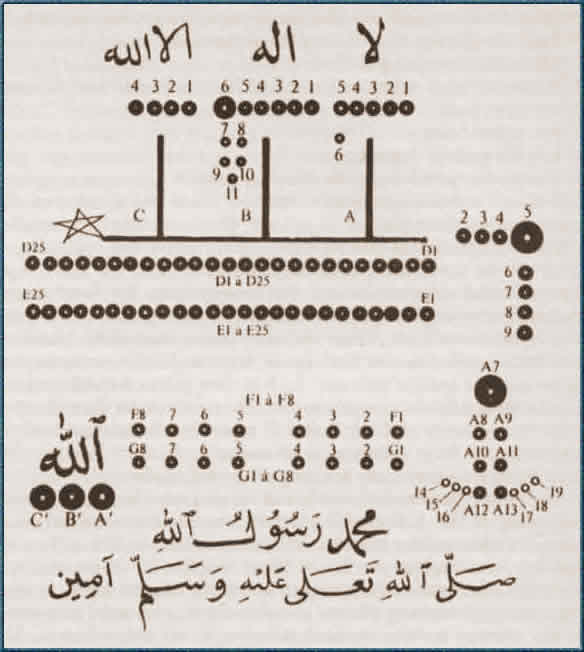University of California Press
Berkeley & Los Angeles. 1984. 215 p.
The mâ'd-dîn is the second lesson of the oral catechism which Cerno Bokar composed and taught in Bandiagara. The full text of the catechism can be consulted in VE, 195-2 39 and TB, 96-120. It is presented in the form of a story in which a Dogon convert named Ancamba requests a Muslim teacher, Sisse, to instruct him in Islam.
The first lesson of the catechism is called “The Primordial Pact,” in which Sisse demonstrates that God has endowed man with reason so that he can employ it in his quest for salvation. It is reason, Sisse explains, which differentiates man from the animals, which among men differentiates the believer from the unbeliever, which among believers differentiates the learned from the ignorant, and which among learned believers differentiates the just from the evil. This lesson ends with Sisse's injunction to Ancamba to “undertake the conquest of religious knowledge,” which at the least requires that one should learn the first and the last ten suwar of the Qur'an, study the concepts of theology which constitute “the esoteric meaning of the shahâda” which is “indispensable and largely sufficient,” learn the prescriptions of ritual purification, and be initiated into Sufism.
The second lesson is the mâ'd-dîn, reproduced here.
The third lesson is called the “Synthesis of the Esoteric
Teaching” or the “Internal Law,” which is a discussion of the general principles of Sufism and of the specific injunctions of the Tijaniyya order.
Each lesson of the catechism was accompanied by a mnemonic pattern of lines and dots which was traced in the sand to aid the student in remembering the texts.
A modified version of the pattern used in teaching the mâ'd-dîn appears
on p. 95; the letters and numbers have been added to assist the reader in following the progression of the teaching in conjunction with the pattem. The following text has been translated from VE, 209-218; it takes up the conversation between Sisse and Ancamba.
Sisse smoothed the sand, impressed a point into it and said:
— “ Interrogate me.”
Ancamba posed questions and Sisse responded:
Upon what is this path constructed? It is constructed upon three pillars, which are:
Of what does Islam consist? Islam requires five obligatory actions.
What are they? They are:
These are the fundamental dogmas of the degree, Islâm.
Of what does Imân consist? Imân consists of belief in six principles:
Of what does Ihsân consist? Ihsân commands:
Ancamba continued: “I have asked you about the ways. You told me there are seventy-three. You chose one of them and affirmed that it is the only true one leading directly to God. You told me that this path was constructed upon three pillars: islam, imân, and ishân. I learned that each of these pillars is composed of acts and principles. Thus Islâm includes five, lmân six and Ihsân four.
Be patient, Sisse, for I am a novice. It is very important for me to question you so that I can clarify my knowledge.”
Sisse, always obliging, said to him, “Interrogate me as you wish. I will
hide from you nothing of what I know.”
“What,” said Ancamba, “is the esoteric teaching of the double formula of the profession of faith, the shahâda?”
Sisse first placed his finger on the point for Islâm (A1) and then moved it to make a new point (A7) in order to explain:
What is necessary for God? Twenty-five attributes are necessary for God:
What is impossible for God? Twenty-five attributes are impossible with respect to God:
What is contingent for God? The contingent for God constitutes a kind of middle way between the necessary and the impossible attributes. The contingent can either exist (like the necessary) or not exist (like the impossible). For example, the decision, for God, to create or to leave something in the nothingness is contingent.
The twenty-five necessary attributes plus the twenty-five impossible attributes comprise the fifty articles of the hidden teaching of the first part of the shahâda: “ I bear witness that there is no god but God, unique and without partner.”
What, therefore, is the esoteric teaching of the second part — “I bear witness that Muhammad is the servant and the messenger of God”? It is the knowledge of the prophets.
How can one know the prophets?
The prophets are recognised by three states:
What is necessary for the prophets and what is impossible for them? Necessary for the prophets are:
As a result, what is impossible for them are:
What is contingent for the prophets?
Of what does the faith of the prophets consist? It consists of their belief in:
It is therefore impossible for the prophets to deny:
The total of that which is necessary, impossible and contingent for the prophets, added to their articles of faith, constitutes the sixteen articles of the esoteric teaching of the second formula of the profession of faith:
“I bear witness that Muhammad is the Servant and Messenger of God.”
We have related the assertion of the scholars, “Whoever does not possess knowledge of the hidden teaching of the double formula of the profession of faith, articulates it without effect.” And whoever articulates it without effect is not a believer, and the unbeliever is not on the way toward salvation.
We are thus happy to note — and we thank God for it — that the teaching of the shahâda consists of fifty articles for the first formula and sixteen for the second, a total of sixty-six [sittu wa sittuûna — the numerical equivalent of the word Allah].
May God, Who has enabled us to know these sixty-six points, cause us to utter the shahâda at the moment of our death, as the last act of our life, Amen.
